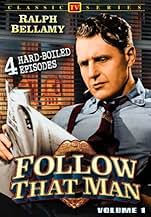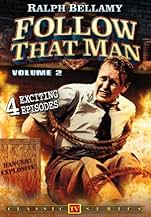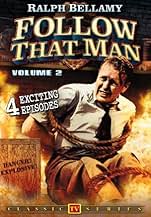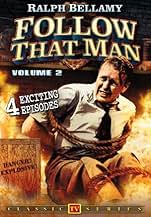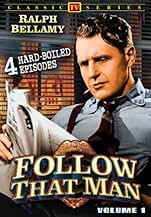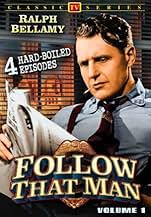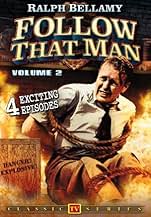Añade un argumento en tu idiomaMike Barnett is the title character, a bright and tough private detective in New York. This very violent show was broadcast live until 1952.Mike Barnett is the title character, a bright and tough private detective in New York. This very violent show was broadcast live until 1952.Mike Barnett is the title character, a bright and tough private detective in New York. This very violent show was broadcast live until 1952.
Explorar episodios
Argumento
¿Sabías que...?
- CuriosidadesWhen the show first was broadcast in 1949, Ralph Bellamy was still appearing on Broadway in "Detective Story" and would be rushed by squad car to the theater, which held the curtain on broadcast nights as late as 9:00 to accommodate the actor.
- ConexionesFeatured in Television: The Story Machine (1985)
Reseña destacada
In the early days of television most of the shows were either patterned after hit radio series such as "Gunsmoke" or based on old movies such as "Topper." There were a few originals though such as the great "I Love Lucy" and "Your Show of Shows." Even the originals tended to utilize known radio and film stars when possible. Most of the big stars of Hollywood, however, believed that television would hurt their image. For example, John Wayne was sought to play Matt Dillon on TV's "Gunsmoke." He declined but recommended a friend who was just starting out in cinema James Arness, whose biggest role up to that point had been the unrecognizable "The Thing." Radio's Matt Dillon, stocky William Conrad, just did not fit the visual image of Mr. Dillon.
Ralph Bellamy had been a top Hollywood star in the 1930's playing mainly in romantic comedies, such as "The Awful Truth" and "His Girl Friday." As he grew older, parts began drying up for the versatile actor as times and tastes changed. Bellamy stayed in shape and his rugged handsome features drew the attention of the television producers putting together a tough, somewhat violent series about a crime busting PI named Mike Barnett. The show was to be called "Follow That Man," since surveillance was one of Mike Barnett's main duties. Later the title was changed to "Man Against Crime." The show was shot in New York City, at first live. Mike Barnett made handy use of his fists when need be. He also liked to solve crimes alone, without much help from other law enforcement authorities, although the local police did call Barnett in from time to time to help them solve a case. He never had a partner or confidant. Even the show's opening was violent. A man is shown running at breakneck speed down a deserted New York City street being chased by a man driving a black car. The running man ducks into a building and up the stairs to Mike Barnett's office. But before Barnett can answer the knock, the running man is riddled with bullets from a submachine gun. When Barnett opens the door he too is shot at but missed. He then gives chase to the killer. "Follow That Man" appears in bold letters, the title of the particular episode is shown and the action begins.
When Bellamy left the series, there was a brief attempt to revive the show with Frank Lovejoy playing Mike Barnett. Bellamy was one of the few actors who went from movies to television and then back to movies. He continued acting the rest of his life and had important roles in such box office hits as "Trading Places" and "Pretty Woman." He also did TV appearances until his death in 1991. Today his most remembered role is playing Franklin D. Roosevelt in "Sunrise at Campobello" and "The Winds of War."
Ralph Bellamy had been a top Hollywood star in the 1930's playing mainly in romantic comedies, such as "The Awful Truth" and "His Girl Friday." As he grew older, parts began drying up for the versatile actor as times and tastes changed. Bellamy stayed in shape and his rugged handsome features drew the attention of the television producers putting together a tough, somewhat violent series about a crime busting PI named Mike Barnett. The show was to be called "Follow That Man," since surveillance was one of Mike Barnett's main duties. Later the title was changed to "Man Against Crime." The show was shot in New York City, at first live. Mike Barnett made handy use of his fists when need be. He also liked to solve crimes alone, without much help from other law enforcement authorities, although the local police did call Barnett in from time to time to help them solve a case. He never had a partner or confidant. Even the show's opening was violent. A man is shown running at breakneck speed down a deserted New York City street being chased by a man driving a black car. The running man ducks into a building and up the stairs to Mike Barnett's office. But before Barnett can answer the knock, the running man is riddled with bullets from a submachine gun. When Barnett opens the door he too is shot at but missed. He then gives chase to the killer. "Follow That Man" appears in bold letters, the title of the particular episode is shown and the action begins.
When Bellamy left the series, there was a brief attempt to revive the show with Frank Lovejoy playing Mike Barnett. Bellamy was one of the few actors who went from movies to television and then back to movies. He continued acting the rest of his life and had important roles in such box office hits as "Trading Places" and "Pretty Woman." He also did TV appearances until his death in 1991. Today his most remembered role is playing Franklin D. Roosevelt in "Sunrise at Campobello" and "The Winds of War."
- krorie
- 15 nov 2005
- Enlace permanente
Selecciones populares
Inicia sesión para calificar y añadir a tu lista para recibir recomendaciones personalizadas
Detalles
- Fecha de lanzamiento
- País de origen
- Idioma
- Títulos en diferentes países
- Follow That Man
- Localizaciones del rodaje
- Empresa productora
- Ver más compañías en los créditos en IMDbPro
- Duración30 minutos
- Color
- Mezcla de sonido
- Relación de aspecto
- 1.33 : 1
Contribuir a esta página
Sugerir un cambio o añadir el contenido que falta

Principal laguna de datos
By what name was Man Against Crime (1949) officially released in Canada in English?
Responde
